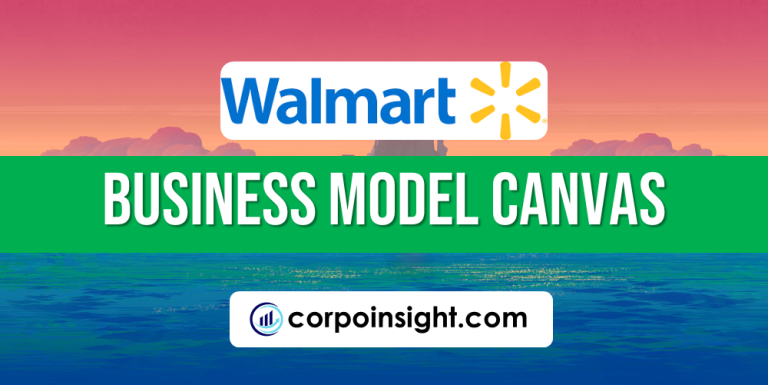Amazon Business Model Canvas 2024
Amazon is an online marketplace offering a wide range of products at competitive prices, supported by efficient logistics and convenient delivery options, and we all know about this company in one way or another. In this Amazon business model canvas, we will get to know Amazon’s customer segments, value proposition, revenue streams, channels, customer relationships, key activities, key resources, key partners, and cost structure.
Interesting Facts!
Jeff Bezos founded Amazon in 1994 as an online bookstore, initially named “Cadabra Inc.” The name was later changed to Amazon, inspired by the world’s largest river.
Amazon Competitors
Walmart | Alibaba | eBay | Target | JD | Best Buy | Rakuten | Flipkart | Costco | Google Shopping
Customer Segments – Amazon Business Model Canvas
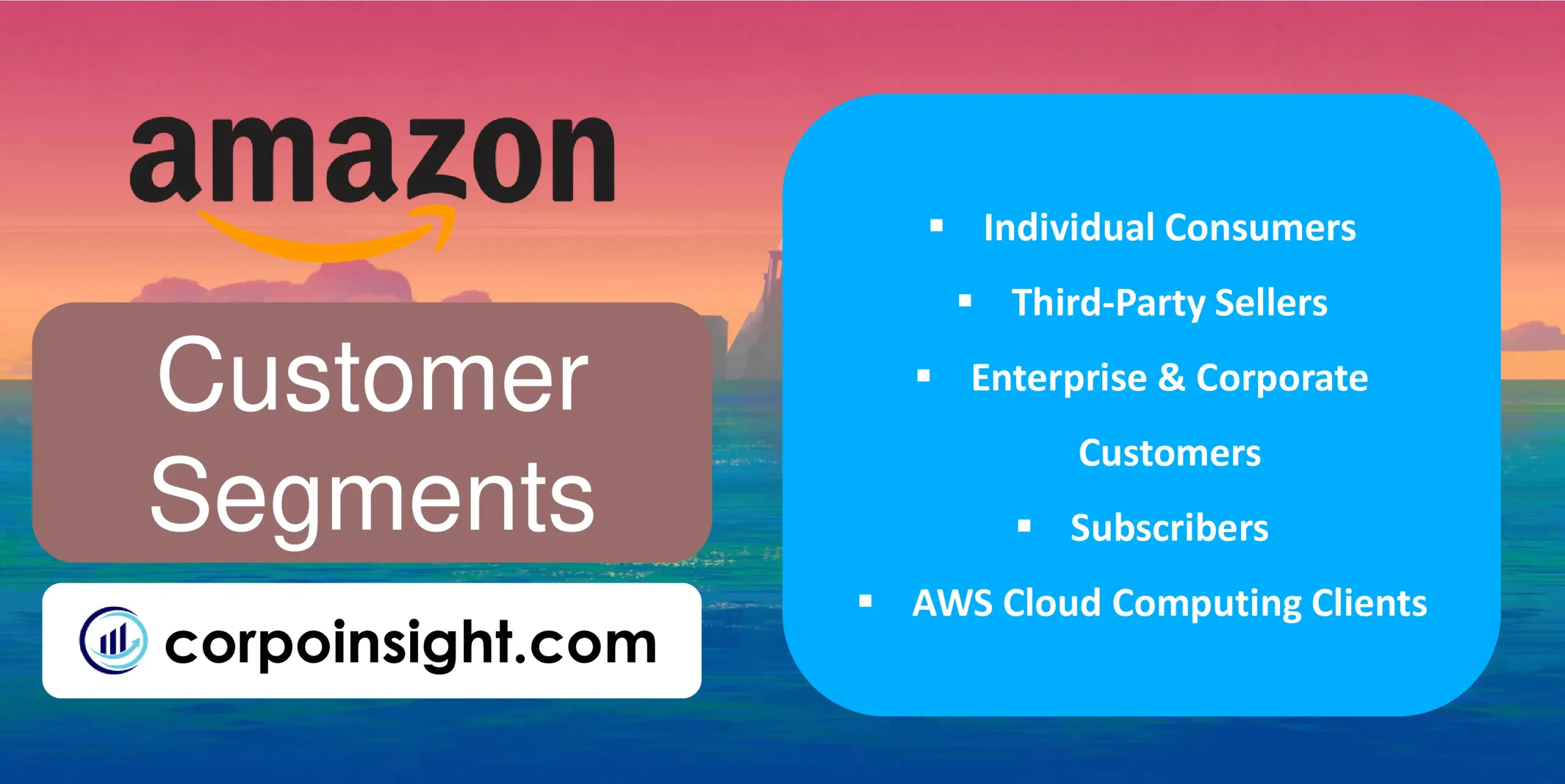
Individual Consumers: As the world’s largest online retailer, Amazon serves over 197 million individual customer accounts. Ranging from one-time shoppers to Amazon Prime members, who spend an average of $1,400 per year due to benefits like free shipping and entertainment.
Third-Party Sellers: Amazon enables entrepreneurs and SMBs to sell products via its marketplace, growing this segment to over 2.3 million sellers. Thereby gaining commissions and marketplace fees from fast-growing channels like Amazon FBA, where the company handles fulfillment and logistics for sellers.
Enterprise & Corporate Customers: Providing bulk purchasing, business pricing, and workflow tools. Amazon Business fuels company growth, serving 45% of the Fortune 500, with over $10 billion in B2B e-commerce sales and 5 million business customers as of 2023.
Subscribers: Services like Prime Video, Amazon Music, and Kindle Unlimited keep over 200 million subscribers locked into the Amazon ecosystem via recurring subscription revenue streams. For instance, Prime alone has over 150 million members globally.
AWS Cloud Computing Clients: With 33% of the $178 billion cloud infrastructure services market, AWS leads competitors. It powers the backend for prominent brands like Netflix, Nike, and McDonald’s. AWS achieved $62 billion in revenue last year across over 1 million customers.
Value Proposition – Amazon Business Model Canvas
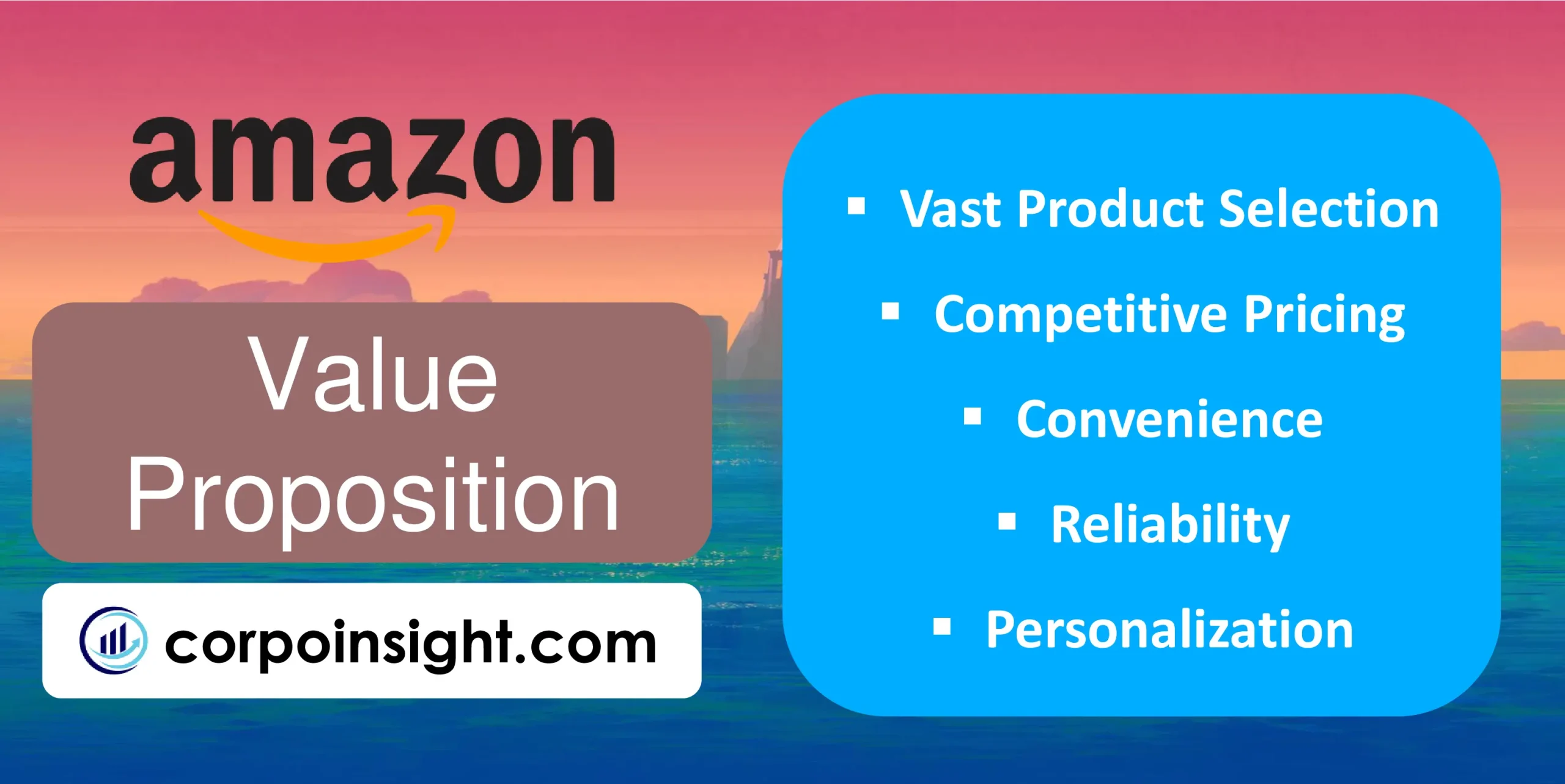
Vast Product Selection: Offering over 12 million products in the US store alone, Amazon touts Earth’s biggest selection. Carrying popular categories like books, electronics, and apparel alongside niche items that shoppers often can’t find elsewhere.
Competitive Pricing: Rigorous algorithms enable competitive pricing across offerings. Amazon leverages bulk purchasing power to maintain prices 5-10% below big box stores on staple items, saving Prime members even more via free shipping perks.
Convenience: With Prime 1-2 day delivery capabilities, buying online and fast fulfillment eliminates trips to brick-and-mortar stores. Intuitive search and support features, plus simplifying product research and purchase friction points, enhance convenience.
Reliability: Amazon leads peers in logistics and supply chain innovation like container tracking and predictive analytics to enable consistent on-time delivery and order accuracy rates above 99%, earning customer trust.
Personalization: Sophisticated AI algorithms power product recommendations and tailored promotions based on purchase history and browsing data, catering to individual shopper preferences.
Revenue Streams – Amazon Business Model Canvas
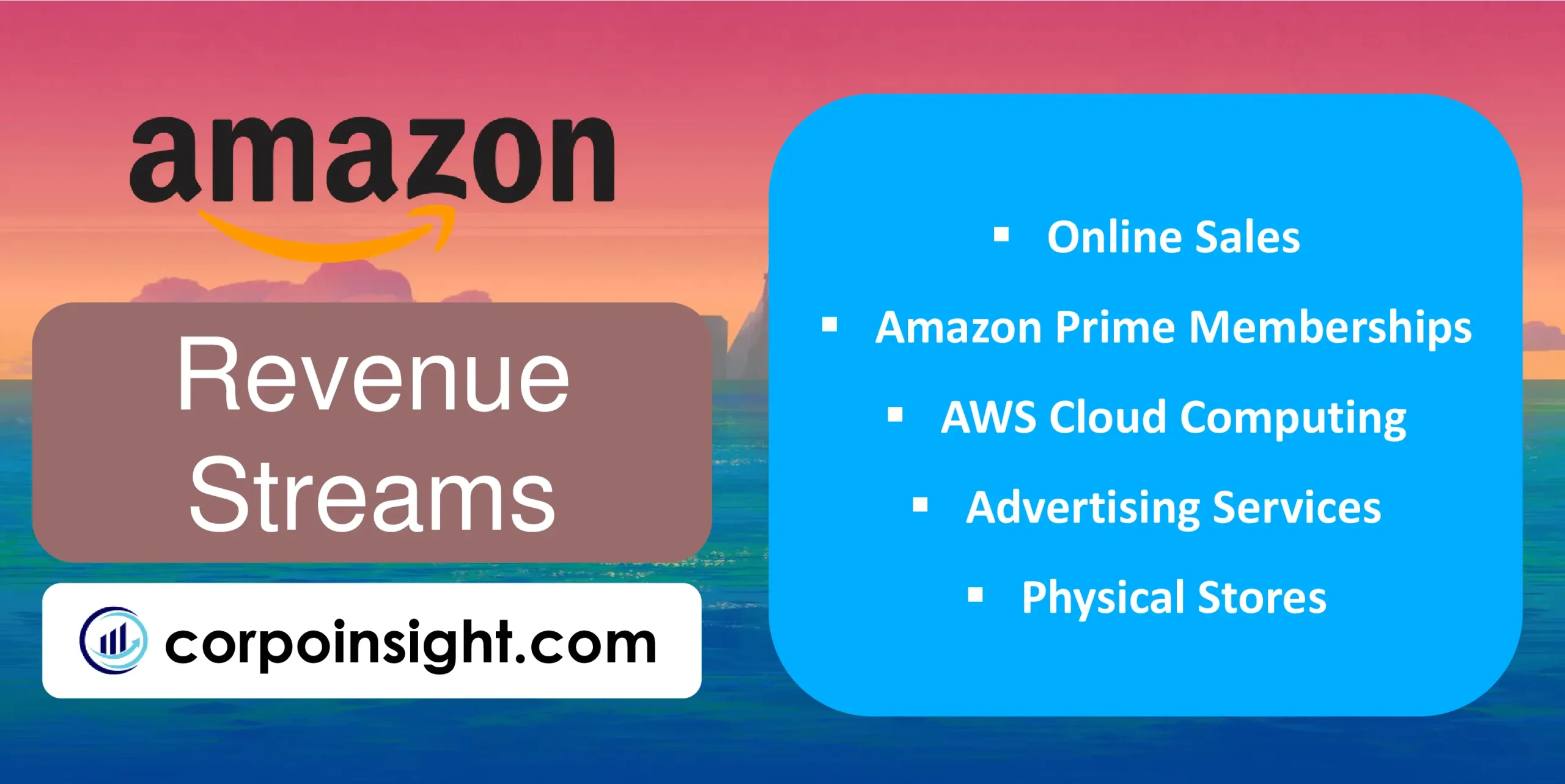
Online Sales: As the #1 global e-commerce retailer, online consumer sales account for over $386 billion in net revenue. Ranging from direct first-party sales to third-party seller services on its leading marketplace, which now represents over 50% of units sold.
Amazon Prime Memberships: The fast-growing segment hit 200 million global subscribers last year. Amazon banks on Prime members spending almost 2x more annually. In turn, the $139 annual fee and additional media subscriptions deliver low churn and reliable revenue.
AWS Cloud Computing: Owning 33% market share, the AWS cloud platform is a $62 billion high-margin business. Offering over 200 cloud infrastructure and development services to industry leaders like Netflix, BMW, and ExxonMobil.
Advertising Services: Rapidly growing advertising across Amazon properties captures 10% of US digital ad spend. Leveraging search keywords and consumer data, Amazon ads increased by 78% last quarter to over $9 billion annually.
Physical Stores: Though online is still its bread and butter, Amazon brick-and-mortar retail delivered nearly $17 billion last year across convenience/grocery concepts like Amazon Go and Whole Foods locations.
Channels – Amazon Business Model Canvas
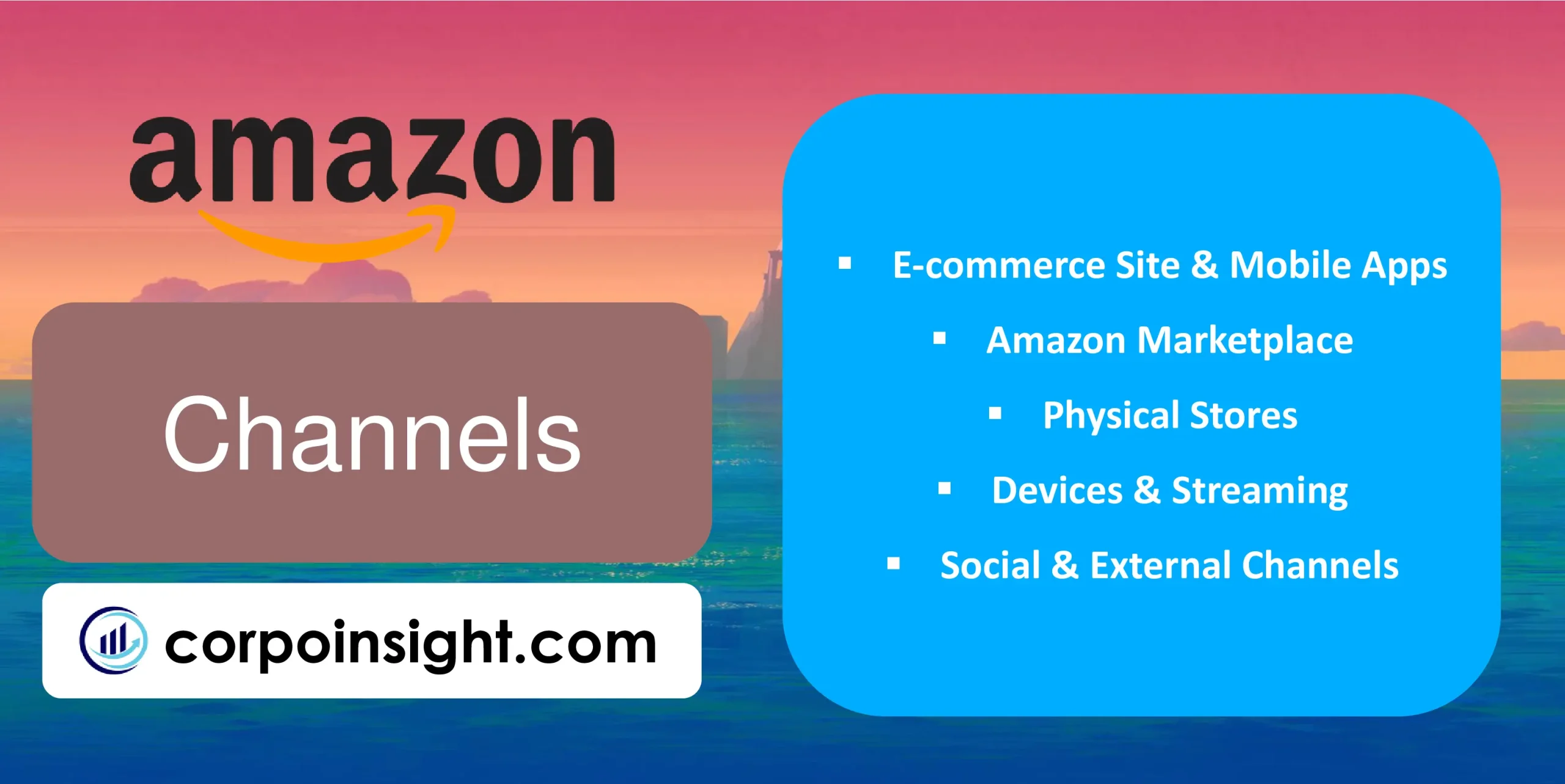
E-commerce Site & Mobile Apps: These proprietary channels drive the bulk of Amazon’s sales. The user-friendly site and apps handled over 2.6 billion monthly visits last year. Ongoing optimization continues growing conversion rates.
Amazon Marketplace: The integrated e-commerce channel enables 2.3+ million third-party sellers to tap into the platform’s vast shopper base, shipping items directly or via Fulfillment by Amazon. It saw 5 billion+ visits annually.
Physical Stores: Amazon leverages channels like Whole Foods grocery stores it acquired along with over 25 Amazon Go convenience shops to capture more consumer spending through brick-and-mortar exposure.
Devices & Streaming: Proprietary smart home devices plus entertainment streaming integrate shopping directly into millions of Fire TV and Alexa ecosystems. 30% of shoppers use Alexa-enabled devices to purchase items.
Social & External Channels: Shoppable posts on Instagram and Pinterest, plus external ads, build awareness and trials. Amazon managed over 1 billion social impressions last Prime Day event alone, for instance.
Customer Relationships – Amazon Business Model Canvas
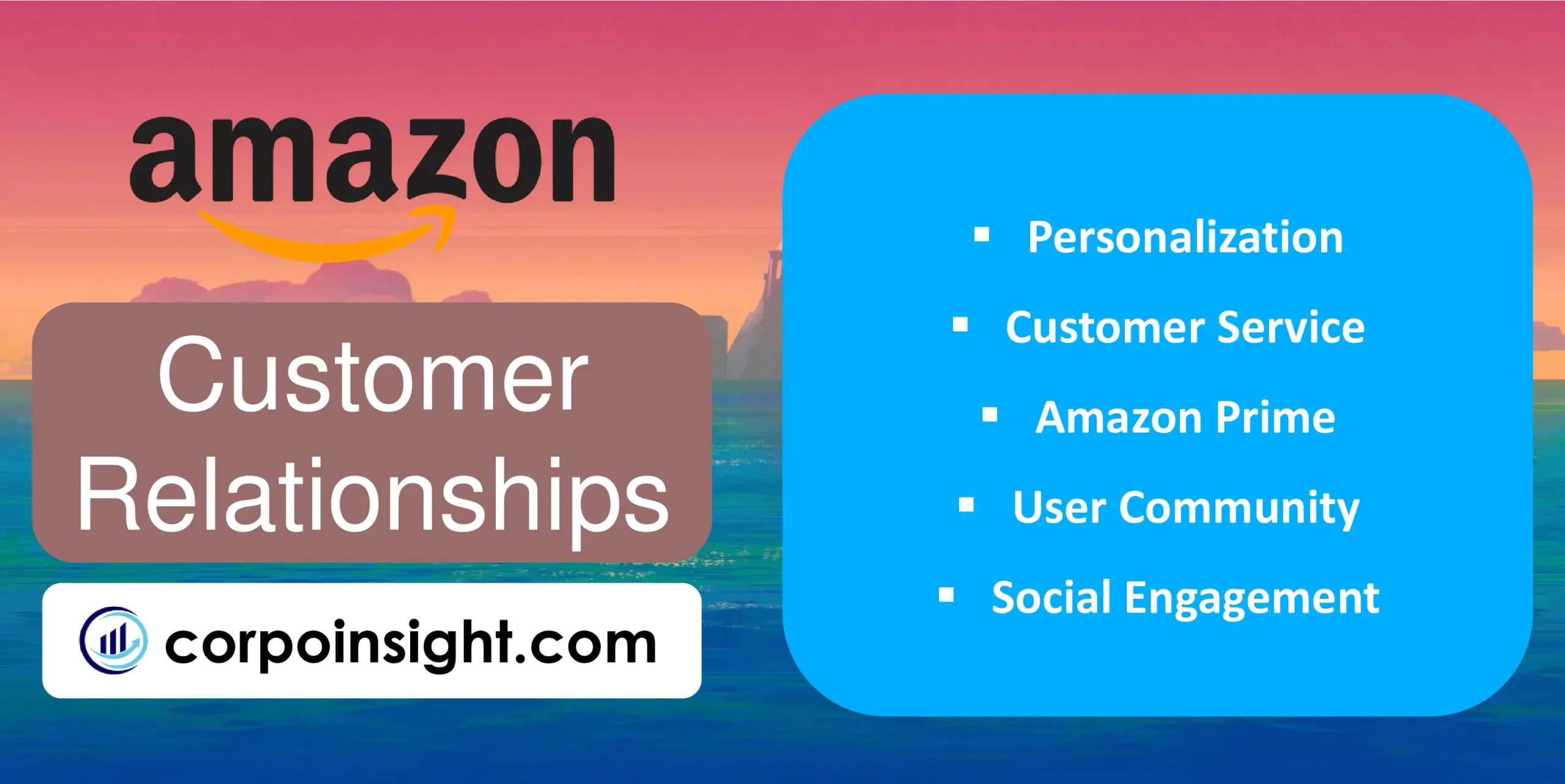
Personalization: Sophisticated AI algorithms deliver individualized recommendations and promotions. For example, item suggestions drive 35% of Amazon’s revenue. Shoppers see unique deals based on order history and preferences.
Customer Service: Amazon spends heavily on user-friendly self-service for order tracking and education, plus in-depth phone, chat, and email support with short wait times to quickly resolve issues with 306 million support cases fielded.
Amazon Prime: The paid loyalty program builds deep relationships with over 200 million members via free fast shipping, media subscriptions, and deals. Prime drives higher LTVs and insulates Amazon from competition.
User Community: Consumers rate and review over 277 million products on Amazon to inform others’ buying decisions. This builds trust through shared experiences and relationships with other shoppers.
Social Engagement: Amazon builds a community with 180 million followers across its social channels. Posts highlighting products, brand values, and promotional content nurture high engagement levels that strengthen relationships.
Key Activities – Amazon Business Model Canvas

Online & Physical Retail: As an e-commerce leader, Amazon sells products directly to consumers through online channels and over 600 retail stores it has acquired or built, turning over $386 billion in consumer retail revenue annually.
Third-Party Seller Services: By providing the marketplace, fulfillment, and delivery capabilities to enable over 2.3 million businesses and entrepreneurs to sell on Amazon, seller services revenue has grown to over $103 billion.
Subscription Services: Leveraging over 200 million Prime subscription members alone, Amazon has built high-margin media and content subscription services like Prime Video, Music Unlimited, Audible, and Kindle Unlimited.
Cloud Computing Platform: Amazon Web Services dominates the $178 billion IaaS market with a 33% share by enabling startups and enterprises alike to lease on-demand cloud computing servers, storage, databases, and other IT resources.
Product Development: From Kindle e-readers to Echo smart speakers, Amazon designs, engineers, and launches popular proprietary devices and services, fueling strong brand loyalty and repeat purchases within its ecosystem.
Key Resources – Amazon Business Model Canvas
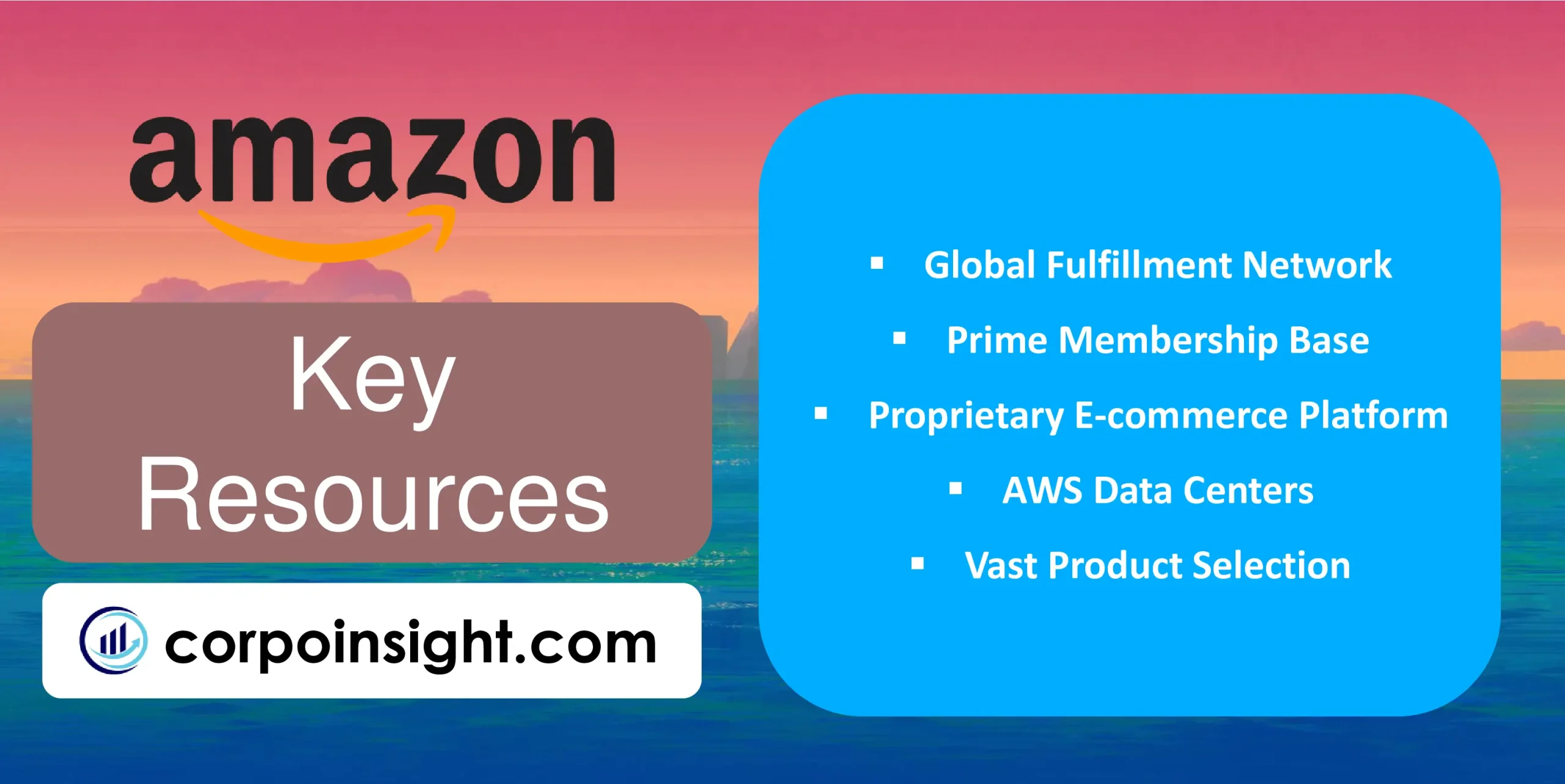
Global Fulfillment Network: With over 450 active fulfillment and sortation centers worldwide totaling over 600 million square feet of space, Amazon has the largest and most sophisticated distribution operation on Earth to meet soaring order volumes.
Prime Membership Base: Boasting over 200 million subscribers globally, this fast-growing, loyal user base provides recurring revenue and higher lifetime values while serving as a competitive buffer that will continue fueling Amazon’s rise.
Proprietary E-commerce Platform: The amazon.com platform and backend order management applications have been refined over 25 years into highly optimized, reliable systems enabling innovations like one-click purchases and efficient handling of 5.6 million daily transactions.
AWS Data Centers: Supporting its industry-leading AWS cloud business line are an expanding fleet of data centers housing millions of servers. With 84 Availability Zones across 26 regions, AWS offers unparalleled geographic reach.
Vast Product Selection: Continuous expansion of Amazon’s online catalog across media, grocery, apparel, household goods, and more key categories provides consumers with an unrivaled single source to purchase just about anything online.
Key Partners – Amazon Business Model Canvas

Delivery/Logistics Providers: Rather than develop in-house fleets, trusted partners like USPS, UPS, FedEx, and new emerging providers fulfill Amazon’s crucial last-mile deliveries to homes and businesses across every locale it serves.
Merchants & Third-Party Sellers: The Amazon Marketplace now hosts over 2.3 million SMB sellers across 37 countries who rely on Amazon’s storefront, fulfillment infrastructure, and 300+ million shoppers to expand their business.
AWS Enterprise Customers: Major brands like Airbnb, GE, and Samsung partner closely on developing cloud solutions leveraging AWS’s unmatched portfolio of on-demand development products and global data center access.
Media & Entertainment Companies: To build out video streaming, music, and ebook libraries, Amazon has forged partnerships with all major studios, record labels, and publishers, plus thousands of independent creators to bring desired titles to Amazon Prime members.
Brick-and-Mortar Retailers: The acquisition of 470 Whole Foods locations expanded Amazon’s physical footprint overnight in support of an omnichannel experience, complemented by additional small-format store pilots underway.
Cost Structure – Amazon Business Model Canvas
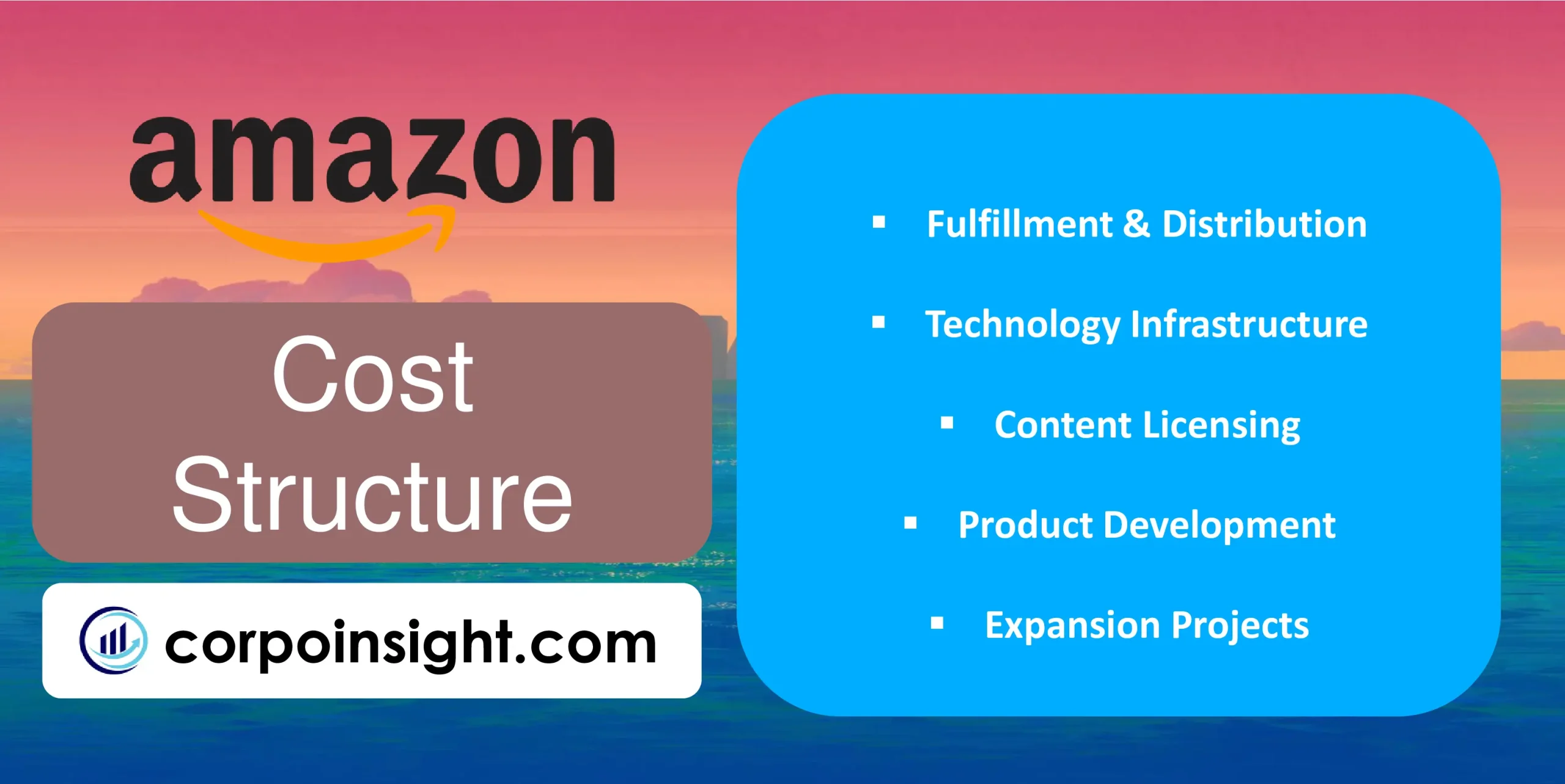
Fulfillment & Distribution: Global logistics comprise the bulk of costs. Across 500+ warehouses, inventory, shipping, delivery, and customer service expenses totaled $96 billion last year as shopping volumes and Prime free shipping strain operations.
Technology Infrastructure: From website hosting to AWS data centers, Amazon spends heavily on tech upkeep and global energy costs. While AWS drives strong profits, retail side infrastructure for ordering systems and supply chain control required over $35 billion last year.
Content Licensing: To host endless virtual shelves of media, Amazon invested $11 billion alone last year on rights from music labels, movie studios, and book publishers to stream content via Prime Video, Music Unlimited, and Audible.
Product Development: Designing leading devices like Alexa home assistants, Echo speakers, and Kindle e-readers, plus associated R&D and launches, comes at a high cost yet delivers halo effects, keeping customers hooked on Amazon’s ecosystem.
Expansion Projects: New fulfillment centers worldwide and growth initiatives around grocery, healthcare, and emerging markets lead Amazon to maintain aggressive, long-term infrastructure investment, outpacing present demand. Spending should generate future efficiency gains.
Summary of Amazon Business Model Canvas
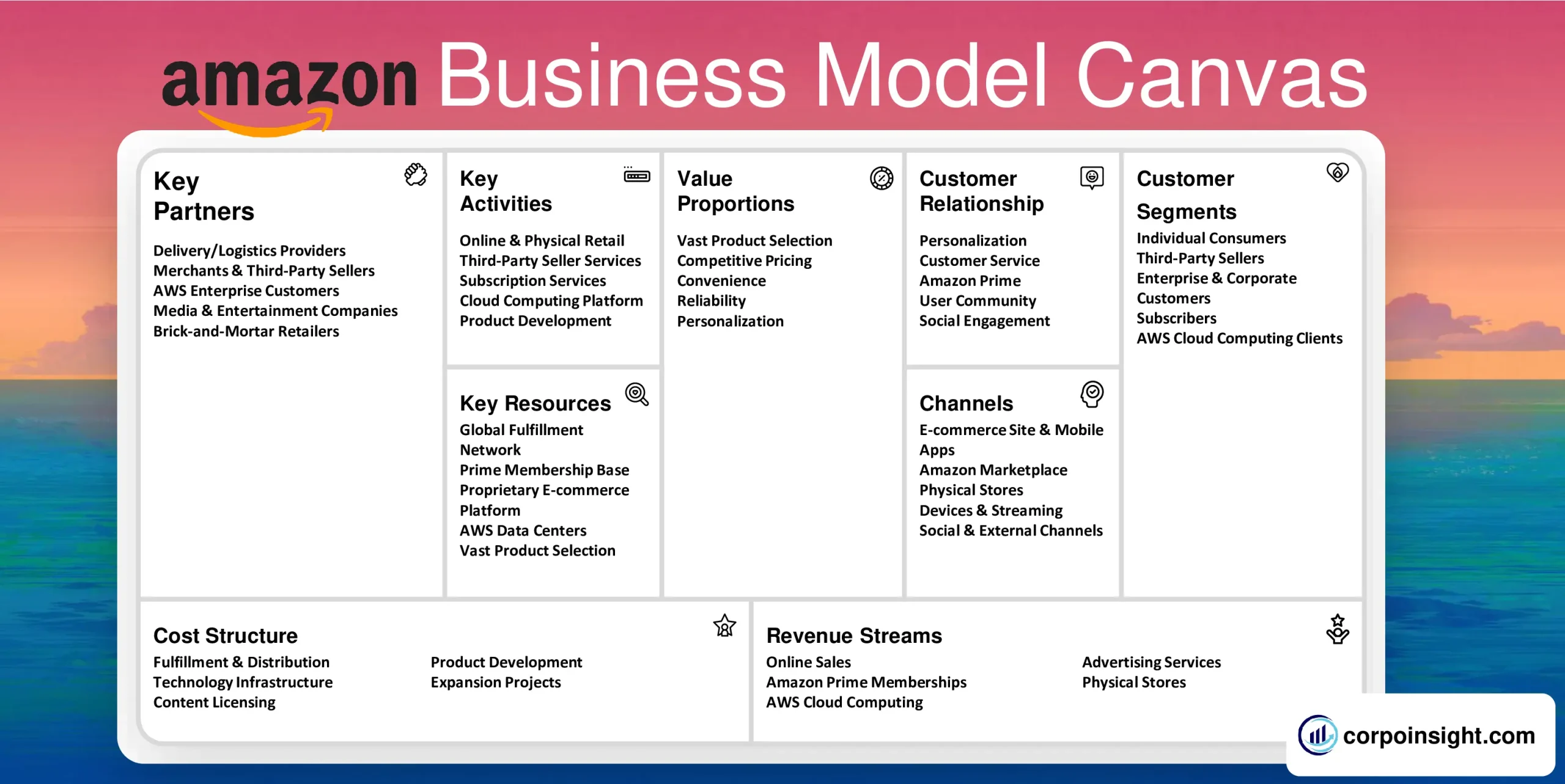
Conclusion on Amazon Business Model Canvas
Amazon’s Business Model Canvas exemplifies disruptive innovation. Its customer-centric approach, facilitated by an expansive platform, diverse product range, and robust logistical network, drives scalability and market dominance. Leveraging technology for efficiency and customer satisfaction, Amazon fosters continuous growth through strategic partnerships and diversification. This model’s success hinges on relentless innovation, customer obsession, and operational excellence, setting a benchmark for modern e-commerce ecosystems.

Hi! I am Mohammad Safayet Hossain, pursuing my BBA in Marketing at the Bangladesh University of Professionals. As a business student, I am passionate about learning about various companies and industries and am here to share them with you.



